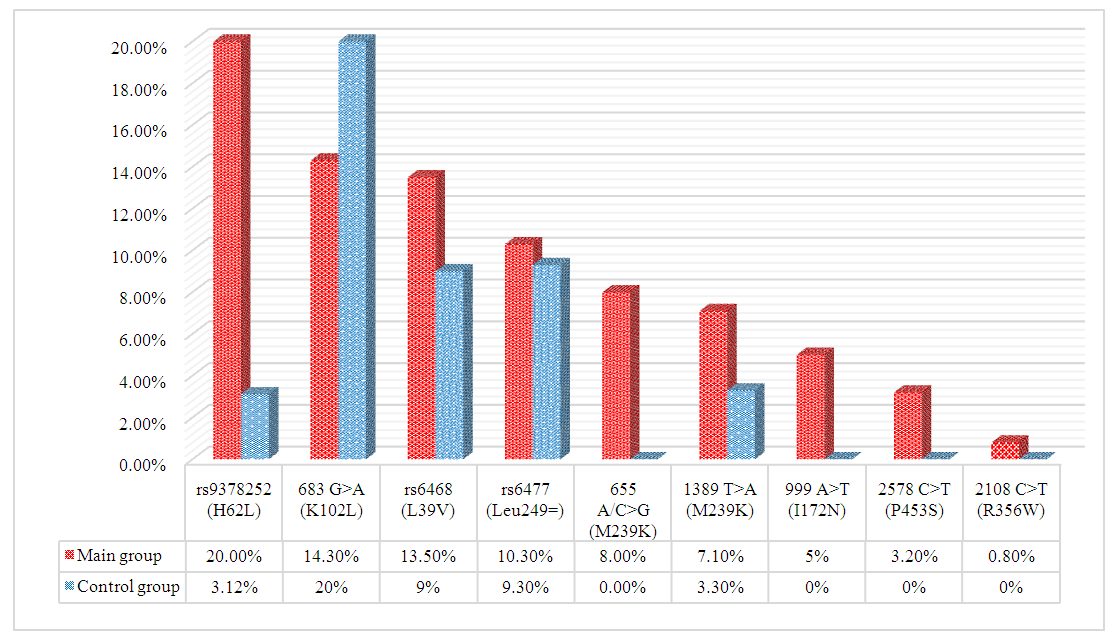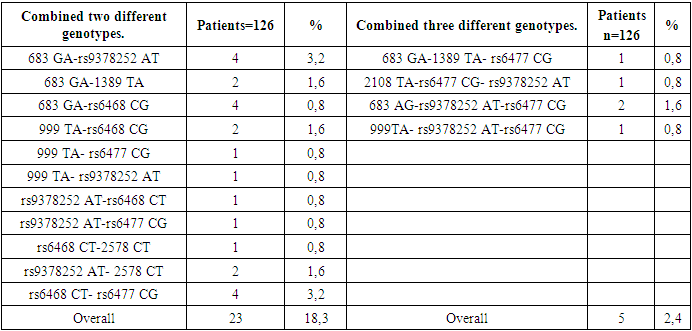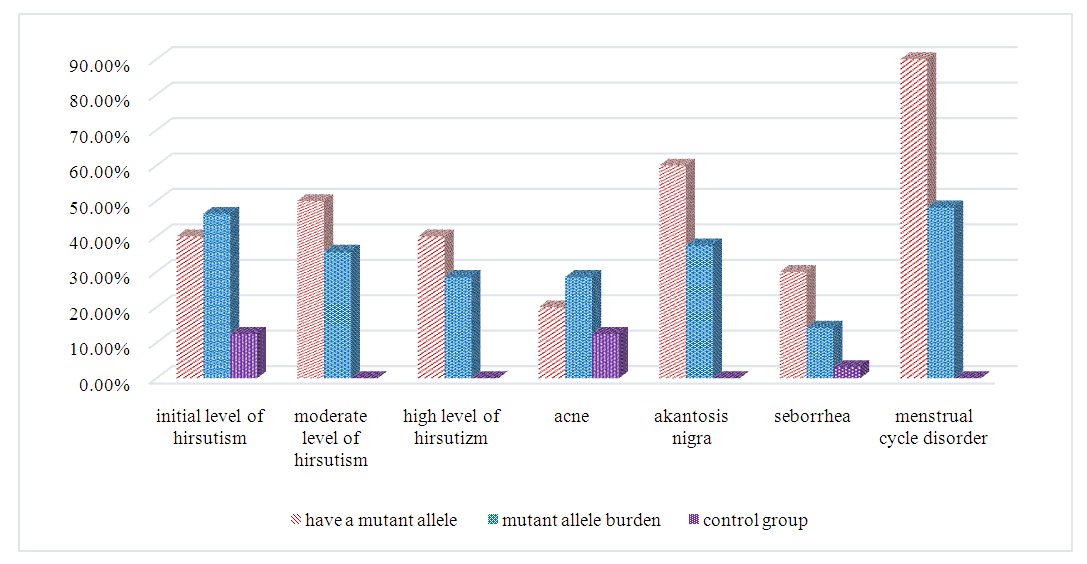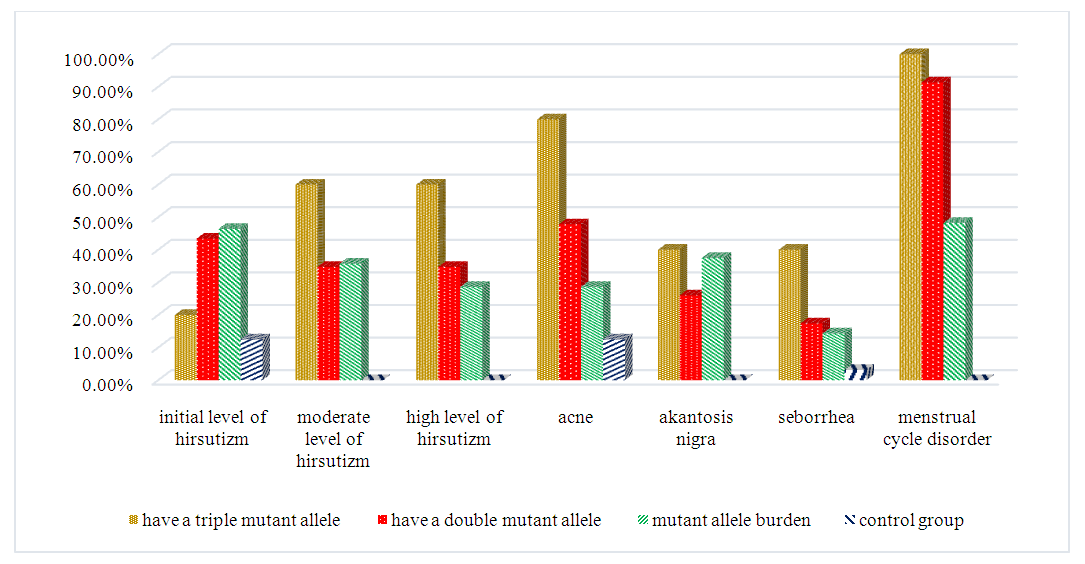Bobokulova Sarvara Bakhtiyorovna
Bukhara State Medical Institute, Bukhara, Uzbekistan
Correspondence to: Bobokulova Sarvara Bakhtiyorovna , Bukhara State Medical Institute, Bukhara, Uzbekistan.
Copyright © 2023 The Author(s). Published by Scientific & Academic Publishing.
This work is licensed under the Creative Commons Attribution International License (CC BY).
http://creativecommons.org/licenses/by/4.0/

Abstract
Objective: The study was conducted on reproductive-aged women with hyperandrogenism. Subjects and methods: For the study, 126 women of reproductive age with hyperandrogenism and 32 women of reproductive age without reproductive function disorders were selected. Anamnestic-clinical, molecular-genetic (sequencing of the CYP21A2 gene), and statistical analysis were used. Results: Regarding hyperandrogenic dermatopathies, the largest proportion consisted of symptoms of acne and black acanthosis. According to the results of CYP21A2 gene sequencing, mutant alleles were more commonly found in the polymorphisms RS9378252 (H62L), 683 G>A, RS6468 (l39v). In the analysis of polymorphism combinations, patients with double polymorphism accounted for 18.3%, while patients with triple polymorphism accounted for 5%. Conclusion: In the analysis of the role of identical polymorphisms in the CYP21A2 gene in the development of independent hyperandrogenism based on clinical symptoms and occurrence of phenotypic changes, polymorphism 655a/C>G, RS9378252 predominated over the frequency of occurrence of acne and menstrual cycle disorders in patients with a predominance of mutant allele in the CYP21A2 gene compared to the frequency of occurrence in undetermined patients.
Keywords:
Hyperanrogenism, Infertility, CYP21A2 gene, Molecular genetic analysis, Congenital adrenal hyperplasia
Cite this paper: Bobokulova Sarvara Bakhtiyorovna , Phenotypic and Genotypic Association in Hyperandrogenic Syndrome, American Journal of Medicine and Medical Sciences, Vol. 13 No. 11, 2023, pp. 1622-1627. doi: 10.5923/j.ajmms.20231311.07.
1. Introduction
The frequency of hyperandrogenism syndrome, one of the current problems in endocrine gynecology, among women of reproductive age is 15-20% [1,2,3]. Hyperandrogenism, in turn, is a leading cause of endocrine infertility. Timely elimination of reproductive disorders caused by hyperandrogenism plays an important role in improving the quality of life for women [4]. Since there are many sources of hyperandrogenism in the female body, there are certain difficulties in its diagnosis. Increased synthesis of androgens is more often observed as a result of morphological changes in the ovaries or hyperplasia of the adrenal cortex [5,6]. Genetic factors are most often the basis for neuroendocrine dysfunction in the female body, so attempts to determine certain ethnic characteristics suitable for a specific population are more common. One genetic factor is CYP21A2, which is responsible for the expression of the 21-hydroxylase enzyme that regulates hormonal function in a woman's adrenal glands. Many scientific studies have shown that a deficiency in 21-hydroxylase leads to hyperandrogenism and its associated clinical manifestations [7,8]. The aforementioned changes and increased secretion of androgen hormones depend on the nature of genetic polymorphism as well as individual sensitivity within a woman's body. Therefore, differential diagnosis and pathogenetically justified treatment of hyperandrogenism are crucial for preventing adverse complications related to impaired reproductive potential in women [9].The aim of the study: Improving the diagnosis of this syndrome through studying phenotypic-genotypic correlations in hyperandrogenism syndrome.Object of research. 126 women of reproductive age with hyperandrogenism and 32 healthy women without reproductive disorders were admitted to the Bukhara Regional Center for Reproductive Health.
2. Research Method
In the study, anamnestic, clinical, and molecular-genetic methods were used. The Ferriman-Gallwey scale was used to assess the degree of hirsutism. Amplification of the СYP21A2 gene sequence was performed during a molecular genetic study. Peripheral blood was obtained from selected women. The product obtained for the study was processed using the GeneAmp® PCR System 9700 device. Polymerase chain reaction products were analyzed on a Complex-3500 automated genetic analyzer (Applied Bio-systems, USA). Amplified genomic DNК sequence was determined using a set of special reagents from Applied Bio-systems (USA) and Data Collection Software 3.0 special computer program. Using the MEGA special computer program, the image of the spectrum reflecting the DNК sequence of all the studied objects was obtained. Molecular genetic research was conducted in the laboratory of the Scientific and Practical Center of Sports Medicine of the Republic.
3. Results and Their Discussion
In the main group of women examined, the number of patients aged up to 20 years was 9 (7.1%), while the number of patients aged 21 to 26 years was 52 (41.3%), and the number of patients aged 27 to 34 years was 41 (32.5%), and the number of patients aged 35 years and older was 24 (19%). Based on data obtained from objective external appearance assessment of subjects in the main and control groups, skin changes related to hyperandrogenism were evaluated. Accordingly, acne and black acanthosis occupied the largest share. | Figure 1. The results of skin changes in women with hyperandrogenism |
The level of hirsutism in the examined women was evaluated using the Ferriman-Gallwey scale, and the following results were obtained: | Figure 2. The frequency of hirsutism occurence in women in the study |
As shown in figure 2, it was found in 75.4% of patients in the main group, while this condition was registered in 12.5% of the control group (p<0.05).The gene sequencing analysis of CYP21A2 conducted in our study showed that mutation types that strongly affect the conformation of the expressed enzyme, such as deletion, translocation, micro- and macro-conversion, were not identified in the main group, while single nucleotide polymorphism (SNP) mutations were identified. | Figure 3. Results of gene sequencing CYP21A2 |
The results of sequencing the CYP21A2 gene showed that mutant alleles were more frequently observed in polymorphisms RS9378252 (H62L), 683 G>A, RS6468 (L39V), as shown in the diagram. At the same time, the combination of identified polymorphisms studied through double and triple additions.Table 1. Analysis of combined double and triple matches of polymorphisms identified during sequencing of the CYP21A2 gene was performed
 |
| |
|
Double and triple merging of identified polymorphisms frequently results in a deficiency of the 21-OH enzyme, accelerating disease progression. Mutations causing severe forms of 21-OH deficiency lead to the development of non-classical adrenal hyperplasia through the occurrence of relatively mild 21-OH deficiency, often as a result of combined effects of various single nucleotide polymorphisms. For this reason, we investigated the relationship between phenotypic changes in patients with different mutations identified in our study and compared them to indicators found in patients where no mutation was detected. Specifically, patients with the polymorphism 655A/C>G mutation identified by CYP21A2 sequencing were compared to a control group with hyperandrogenism who only retained a wild homozygous-normal genotype in the CYP21A2 gene (N=56). | Figure 4. Comparison of phenotypic changes in the control group with patients who had the polymorphism 655A/C > G identified in the CYP21A2 gene, and patients who did not have any mutations detected in the CYP21A2 gene |
As shown in Figure 4, when comparing patients with a mutant allele not identified in the CYP21A2 gene and patients with a minor allele polymorphism 655a/C>G identified in the CYP21A2 gene, there was a statistically significant difference only in the clinical manifestation of menstrual cycle disorders. Patients who only had wild-type alleles in the CYP21A2 gene, as well as those with the 655a/C>G minor allele - G compared to the control group, did not have a statistically significant advantage in terms of the frequency of acne symptoms in both patient groups. However, for all other clinical manifestations, the frequency of detection among patients in both groups was statistically significantly higher than that of the control group (p<0.05).In order to study the synergistic effect of polymorphisms detected in the study, patients with multiple polymorphism detections, patients with indeterminate mutations, and a control group were examined for phenotypic characteristics. | Figure 5. The occurrence of phenotypic features in patients with triple and double mutations in the CYP21A2 gene and in patients without a mutant allele in the CYP21A2 gene, as well as in the control group |
As shown in Figure 5, patients without polymorphism mutations in the CYP21A2 gene can experience triple (three types of polymorphisms) and double (two types) polymorphisms in the CYP21A2 gene when comparing the frequency of occurrence of clinical features (to assess the synergistic effect of these polymorphisms in patients with more than one type of polymorphism) of menstrual cycle disturbances (specifically, secondary amenorrhea, opsomenorrhea, oligomenorrhea, polymenorrhea and hypermenorrhea) with statistically significant high frequency (respectively, 2.07 (p<0.05) and 1.89 (p<0.05) times), while significantly higher occurrence (2.8-fold - p<0.05) was confirmed in patients with only triple polymorphism features of acne. On the other hand, patients with triple and double polymorphisms showed a statistically significant difference in the frequency of occurrence of all types of clinical features identified in the control group compared to the frequency rates (p<0.05) in patients with mutant alleles type (P>0.05) (only initial stage hirsutism feature showed no statistically significant difference in frequency rates between triple polymorphism and control group (p > 0.05), as well as no statistically significant difference was found for double polymorphism feature in the control group (p>0.05)). The study investigated the significance of the CYP21A2 gene in the development of hyperandrogenism caused by a mutant allele specific to only one type of polymorphism (considering that mutant alleles are mainly present in a heterozygous state) in patients with different polymorphisms. The study also concluded which specific types of mutant alleles can independently cause the development of 21-hydroxylase deficiency in patients with double polymorphism. | Figure 6. Phenotypic changes occur in patients with a specific type of polymorphism in the CYP21A2 gene, as well as in patients without a mutant allele in the CYP21A2 gene, and also in the control group |
As shown in Figure 6, patients with one minor allele type in the CYP21A2 rs9378252 gene polymorphism were dominant at a rate of 2.04 (p<0.05) and 1.89 (p<0.05) compared to patients where the mutant allele was not identified in the CYP21A2 gene, only in terms of acne and menstrual cycle disturbances frequency. The frequency of clinical features in patients with mutant allele in other types of polymorphisms did not show statistically significant differences compared to patients without the mutant allele (p>0.05). The frequency of clinical markers such as mild hirsutism, severe hirsutism, black acanthosis, and menstrual cycle disturbances was significantly higher in patients with a specific type of polymorphism compared to the control group (P<0.05).
4. Conclusions
When analyzing the role of identical polymorphisms in the CYP21A2 gene in the development of independent hyperandrogenism based on clinical features and phenotypic changes in patients with the 655a/C>G polymorphism rs9378252, the mutant allele in the CYP21A2 gene prevailed over the frequency of undiagnosed patients in terms of acne and menstrual cycle disorders. With regards to studying synanthropic effects on the manifestation of clinical features, the frequency of menstrual cycle disorders was statistically significantly higher in women with triple and double mutations compared to women without mutant alleles, while a higher frequency was observed in patients where only triple polymorphism related to acne was detected.
References
| [1] | Azziz R. et al. The Androgen Excess and PCOS Society criteria for the polycystic ovary syndrome: the complete task force report // Fertil. Steril. 2009. Vol. 91. № 2. P. 456–488. |
| [2] | Anastasovska V, Kocova M. Intron 2 splice mutation at CYP21 gene in patients with congenital adrenal hyperplasia in the republic of Macedonia. Balkan Journal of Medical Genetics. 2010; 13: 27–33. |
| [3] | Ashurova N.G., Bobokulova S.B. Rasprostranennost' klinicheskih proyavlenij giperandrogenii u zhenshchin reproduktivnogo vozrasta. \\ Novyj den' v medicine 2 (34/3)2021 S. -105-108. |
| [4] | Bobokulova S. B. Vstrechaemost' giperandrogenii v strukture reproduktivnyh narushenij u zhenshchin\\ Sbornik materialov V mezhdunarodnogo molodezhnogo nauchno-prakticheskogo foruma. 22 aprelya 2021 g. Orenburg. S. -203. |
| [5] | Ashurova N. G., Bobokulova S. B., Zaripova D. Y. Characteristics of clinical and laboratory changes in women with hyperandrogenia// Chinese journal of industrial hygiene and occupational diseases, 2022 P.-413-420. |
| [6] | Arriba M, Ezquieta B. Molecular Diagnosis of Steroid 21-Hydroxylase Deficiency: A Practical Approach. Front Endocrinol (Lausanne). 2022 Mar 29; 13: 834549. |
| [7] | Bobokulova S. B., Ashurova N. G., Ibodov B. Тhe importance of genetic markers in the diagnosis of hyperandrogeny syndrome in women of reproductive age // British Medical Journal, 2023. Volume-3, No 2. P.15-21. |
| [8] | Zaripova D.Yа., Tuksanova D.I., Negmatullaeva M.N. Osobennosti techeniya perimenopauzal'nogo perekhoda zhenshchin s ozhireniem. Novosti dermatovenerologii i reproduktivnogo zdorov'ya. № 1-2. 2020 Str. 39-42. |
| [9] | Bobokulova S. B., Ashurova N. G. Of reproductive age development of hyperandrogenism syndrome in women the pathogenesis of changes in the CYP21A2 genenetic significance \\ Journal Of theoretical And clinical Medicine, №2, 2023. P. -136-140. |





 Abstract
Abstract Reference
Reference Full-Text PDF
Full-Text PDF Full-text HTML
Full-text HTML


